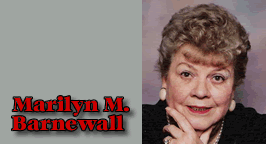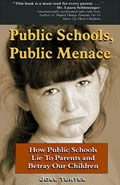By
Marilyn MacGruder Barnewall
November 1, 2015
NewsWithViews.com
Like all things involving money, you need to know the rules of the game
The theft by Congress of Social Security funds has left only IOUs in the non-existent lock-box. Combine that with the criminal methods used to calculate the cost of living and you will find Social Security recipients will receive no cost-of-living increase in their 2016 monthly checks.
Former
Senator Fred Thompson and former superstar Henry Winkler along with a
high-ranking retired military guy appear every-other-minute on  television,
hawking the benefits of taking a reverse mortgage against your home. And
there are many benefits. There are also some downsides... enough that
the Consumer Financial Protection Bureau has issued a warning to seniors
to watch out for them.
television,
hawking the benefits of taking a reverse mortgage against your home. And
there are many benefits. There are also some downsides... enough that
the Consumer Financial Protection Bureau has issued a warning to seniors
to watch out for them.
A reverse mortgage is a loan against the equity in your home. It requires no repayment as long as you live in the home. I repeat, the loan doesn’t have to be repaid until the homeowner dies, sells the house, or moves out for at least 12 months. At that time, you or the person(s) who inherit your home need to pay both the loan and accrued interest. That is usually accomplished by selling the home.
Who owns the house? You, not the bank or mortgage company, own the house. You must keep up your insurance because any liability that is filed against the home – if someone falls in your driveway, for example – may file charges to get compensated for their injuries. You, not the bank or the mortgage company, are responsible. You must also pay your property taxes. In fact, if you don’t pay them the reverse mortgage lender can file foreclosure proceedings against you.
Seniors who find their after retirement cash flow less than needed to maintain their lifestyle may find reverse mortgages helpful. Some people believe it is silly to have their monthly incomes drop at retirement when they finally have time to do things they always wanted to do.
Perhaps a mate has a stroke and requires expensive medical care you cannot afford. Perhaps you have a severe health problem but prefer home nursing services to a nursing home – but cannot afford the cost. Maybe you need to widen doors for wheelchair access, or have a walk-in shower built in your bathroom. Age requires us to adjust to all kinds of changes,.
Your income is an important part of the reverse mortgage qualification process. Your ability to continue paying insurance and property taxes will be evaluated. If your income looks too low, a portion of your loan proceeds may be placed in an escrow account to ensure money will be available to pay them.
Reverse mortgages are often referred to as “rising debt, falling equity” loans. They are given this name because as you receive money from the lender, your debt rises and your equity goes down. When you first bought the home, you had a “falling debt - rising equity” situation. As you made payments each month, your equity rose and your debt decreased.
To qualify for this type of credit, all of the people whose names are on the deed to the home on which a reverse mortgage is requested must be 62 years of age and all must sign the papers involved. Aside from being required to have sufficient income to pay taxes and insurance, your income is not relevant to the credit process. There is no loan repayment. The amount of equity in your home determines the amount of money available to you.
You are charged interest on the money you receive but you make no interest payments during your lifetime. Interest is paid at the end of the loan – when the last living person whose name is on the deed of trust to the property dies, moves out of the home for more than a year, or sells the home.
The federally-insured (by FHA) Home Equity Conversion Mortgage (HECM) requires the property being financed to be a single-family dwelling, a two-to-four unit building (duplex or fourplex), or a federally-approved condominium or planned unit development (PUD).
Most manufactured or mobile homes are not eligible. Some manufactured homes built on permanent foundations may qualify provided they are classed and taxed as real estate and meet other requirements. HECMs have home value limits. The limits vary by county but cannot exceed $625,000. Each program is different in its requirements, so it is impossible to state all of the rules of the game in one article.
The home must be the borrower’s primary residence. If you have a large enough equity position in the home it is possible to get the reverse mortgage and use a portion of the funds to pay any mortgage debt against the property. Aside from that, the home must be debt free.
Suppose you owe $15,000 on your mortgage but need to increase your monthly income. You decide to get a reverse mortgage. Your house is appraised at $250,000.00. Depending on the program you choose – and there are several – you could easily pay the balance remaining on your mortgage and still have a nice sum available to increase your monthly income.
How much can you borrow? On the $250,000 you would probably get about $135,000 with a fixed-rate. You can (and should) go to reversemortgage.org to check out for yourself how much you can borrow. That way you’ll be sure the organization to whom you apply is giving you fair treatment. Reverse mortgages are what lenders call “non-recourse loans.” That means there is no repayment source available to lenders other than the equity in the property on which the loan is made.
There is no repayment schedule. The amount of cash you can get varies. A lot depends on the program you choose and on basic credit factors like your age, the appraised value of your home, and current and projected interest rates.
Various programs fit different and unique consumer needs. Fannie Mae, for example, offers a Home Keeper loan. In February 2001, Fannie waived the equity share fee on all loans of this kind. In May 2001, they discontinued charging a 1 percent fee on Home Keeper loans. Fannie Mae is a good resource to begin gathering information.
Be sure and compare different fees charged by various lenders. When you talk about a large sum of money, fees add up very quickly. Every dollar the lender gets in a fee is a dollar you won’t get. There will be an application fee – it should include the cost of an appraisal. If it does not, be sure to find out that cost.
A basic credit check is done to see if you have defaulted on any federally-insured loans – education loans, for example. Be sure you ask about the total fee structure so there are no surprises at closing. There is usually a 2 percent origination fee for the first $200,000 of the home’s value – not on the $135,000 you will receive, but (in our example) on the $250,000 home value. There is usually a $6,000 cap. There may be a half-point fee paid by the homeowner at loan closing for mortgage insurance premium (MIP). There is also a 1.25 percent MIP annual fee. In other words, you are paying for the lender’s mortgage insurance.
You can get your money in a lump sum or regular monthly checks. Or, you may opt for a line of credit – or a combination of these options. However, if you withdraw more than 60 percent of the loan (the $135,000, not the $250,000 home value) your MIP will increase to 2.5 percent.
Check the sales price of comparable homes in your neighborhood. Divide the number of square feet of each home into the total sales price. That tells you the cost per square foot. Take an average of the per square foot cost on the properties you investigate (if you found the per square foot cost on four properties, add the four numbers and then divide by 4). Multiply the number of square feet in your home by that number and it should give you a good overview of what you are likely to receive in the way of appraised value. The appraisal you receive from your lender should place the value of your home in a similar ballpark.
Utilize the U.S. Department of Housing and Urban Development (HUD) or the AARP Foundation as resources for information. Because of the increased demand for them, AARP has a consumer education program about reverse mortgages. You can also get a booklet, “Use Your Home to Stay at Home,” from the National Council on Aging.
How you receive money – lump sum or monthly payment, e.g. -- from the lender can impact the amount of cash available to you from the reverse mortgage, so ask the right questions.
Remember, the total amount of the loan is anyone’s best guess. It may depend on how long you are expected to live. You will owe the loan balance (all of the cash you received from the reverse mortgage), costs used for loan fees, plus all of the interest up to the loan’s “nonrecourse” limit. Title search, insurance, surveys, inspections, recording fees, mortgage taxes... all can be financed by the loan, but must be repaid.
Social Security and Medicare benefits are generally not impacted by reverse mortgage loans. The IRS generally does not view loans as income.
|
|
If, however, you receive Supplemental Security Income (SSI) and Medicaid, the way you receive cash from a reverse mortgage could cause you to lose benefits. Get legal input from an expert who understands SSI and Medicaid because you can structure your program around potential problems.
With reverse mortgages, you are not borrowing against future earnings. You are using assets you have acquired in the past – an asset you have already paid for – to leverage a more secure, more comfortable future.
When making decisions of this kind, you really need to consider when to use your savings and for what. A house may be a home, but it is also an asset and part of your savings.
� 2015 Marilyn M. Barnewall - All Rights Reserved
Marilyn MacGruder Barnewall began her career in 1956 as a journalist with the Wyoming Eagle in Cheyenne. During her 20 years (plus) as a banker and bank consultant, she wrote extensively for The American Banker, Bank Marketing Magazine, Trust Marketing Magazine, was U.S. Consulting Editor for Private Banker International (London/Dublin), and other major banking industry publications. She has written seven non-fiction books about banking and taught private banking at Colorado University for the American Bankers Association. She has authored seven banking books, one dog book, and two works of fiction (about banking, of course). She has served on numerous Boards in her community.
Barnewall is the former editor of The National Peace Officer Magazine and as a journalist has written guest editorials for the Denver Post, Rocky Mountain News and Newsweek, among others. On the Internet, she has written for News With Views, World Net Daily, Canada Free Press, Christian Business Daily, Business Reform, and others. She has been quoted in Time, Forbes, Wall Street Journal and other national and international publications. She can be found in Who's Who in America, Who's Who of American Women, Who's Who in Finance and Business, and Who's Who in the World.
Web site: http://marilynwrites.blogspot.com
E-Mail: marilynmacg@juno.com
E-Mail: marilynmacg@juno.com













 Share
This Article
Share
This Article



